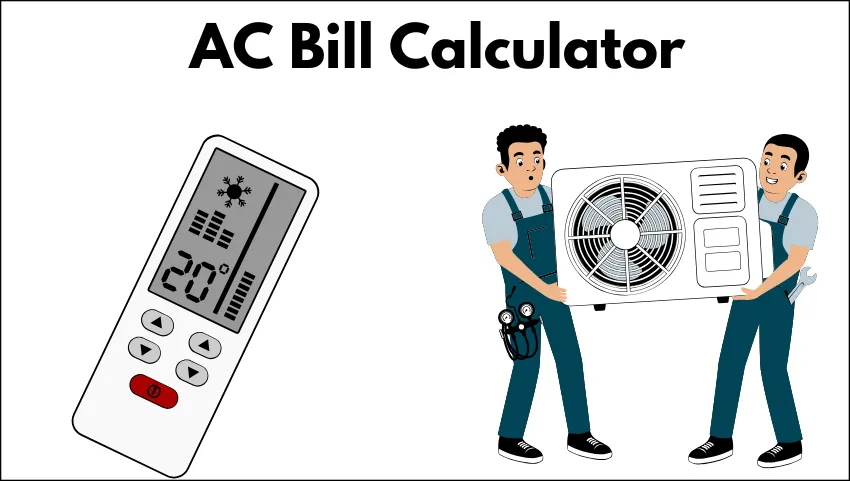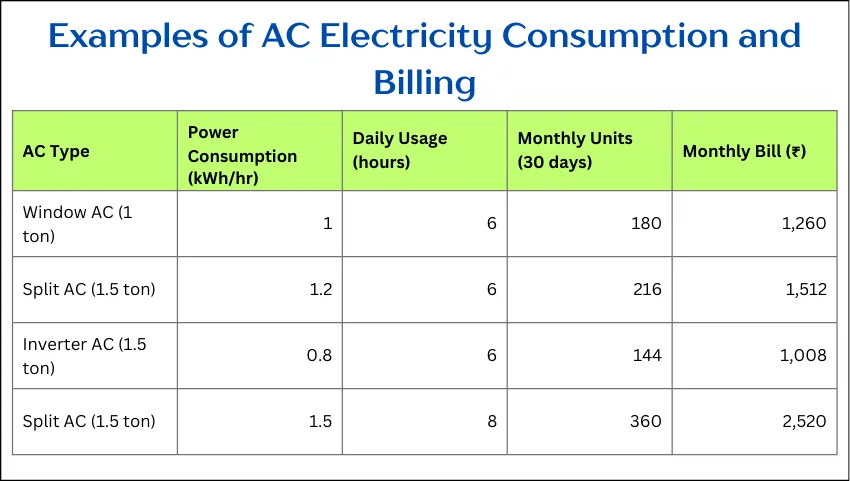AC Bill Calculator
Calculate your monthly air conditioner electricity costs accurately
💡 Tips to Reduce AC Electricity Bills
- Set the AC temperature to 24-26°C for optimal energy efficiency
- Use ceiling fans along with AC to feel cooler at higher temperatures
- Ensure proper insulation and seal air leaks in the room
- Clean AC filters regularly for better performance
- Choose higher star-rated ACs for lower power consumption
- Use timer and sleep mode features when available
- Keep curtains closed during hot days to reduce heat load
Air conditioners (ACs) make our homes and offices comfortable, especially in hot weather. But running an AC increases your electricity bill. Understanding how much electricity your AC consumes and how that translates into your bill can help you manage your usage better and save money.
What Is an AC Bill Calculator?
An AC bill calculator is an online or offline tool that helps estimate:

- The amount of electricity your AC consumes (usually measured in units or kilowatt-hours).
- The approximate cost of running your AC for a specific duration based on the rate charged by your electricity provider.
Using this calculator, you can input your AC’s power rating, daily usage hours, and electricity tariff to get an estimate of the electricity units consumed and the bill for a month or year.
This is very useful to:
- Budget your electricity expenses
- Compare different AC models and their energy efficiency
- Find ways to optimize your AC usage for savings
You can find many free AC bill calculators online, such as the one tailored for Indian users, which considers specific electricity rates and usage patterns .
How Does an AC Bill Calculator Work?
The calculation involves understanding your AC’s power consumption and your electricity rate. Here are the main steps:
Find Your AC’s Power Rating
The power rating tells you how much electrical power your AC uses, typically shown in watts (W) or kilowatts (kW). For example, a 1.5-ton AC might have a power rating around 1500 watts or 1.5 kW.
You can usually find this on the AC label or in its user manual.
Calculate Daily Electricity Consumption
Multiply the AC’s power rating by the hours you use the AC each day. Then convert this into kilowatt-hours (kWh) by dividing by 1000.
Formula: Daily Consumption (kWh) = 1000 × Power Rating (W) × Daily Use (hours)
For example, if your AC is 1500 W and runs for 6 hours daily:1500×6/1000=9 kWh per day
Calculate Monthly Consumption
Multiply daily consumption by the number of days in a month (usually 30). Monthly Consumption (kWh) = Daily Consumption ×30
For the example above : 9×30=270 kWh per month
Calculate Your Electricity Cost
Multiply the monthly consumption by your electricity tariff, typically given in rupees per kWh. Monthly Cost = Monthly Cost = Monthly Consumption × Tariff (₹/kWh)
If the tariff is Rs 7 per unit, your monthly expense would 270×7=₹1890.
Why Does Your AC Electricity Bill Vary?
Several factors cause variation in your AC electricity consumption and bill:
- AC Capacity (Tonnage): Higher tonnage ACs consume more power. For example, a 1-ton AC consumes about 1 kWh per hour, while a 1.5-ton can consume 1.2 to 1.5 kWh per hour.
- Star Rating (Energy Efficiency): ACs come with a star rating from 1 to 5 stars based on energy efficiency. A 5-star AC uses less power compared to a 3-star AC for the same cooling.
- Type of AC: Inverter ACs consume less energy than non-inverter models because they regulate the compressor speed based on cooling needs.
- Usage Hours: More hours of usage will naturally increase consumption.
- Electricity Tariff: Tariffs differ by region and by usage slabs, sometimes increasing as monthly consumption goes up.
- Room Conditions: Poor insulation, direct sunlight, and frequent door/window opening increase AC workload, increasing power consumption.
Examples of AC Electricity Consumption and Billing
Here are some rough monthly consumption and cost estimates based on type and usage, assuming Rs 7 per unit tariff:

| AC Type | Power Consumption (kWh/hr) | Daily Usage (hours) | Monthly Units (30 days) | Monthly Bill (₹) |
|---|---|---|---|---|
| Window AC (1 ton) | 1.0 | 6 | 180 | 1,260 |
| Split AC (1.5 ton) | 1.2 | 6 | 216 | 1,512 |
| Inverter AC (1.5 ton) | 0.8 | 6 | 144 | 1,008 |
| Split AC (1.5 ton) | 1.5 | 8 | 360 | 2,520 |
You can see inverter ACs save money by consuming less power. The more you run your AC, the higher your bill will be. For example, running a 1.5-ton model for 10 hours/day can push your monthly bill above ₹3,500.
How to Use an AC Bill Calculator Online?
Most online AC bill calculators are user-friendly. You just need to enter the following details:
- AC Tonnage (e.g., 1 ton, 1.5 ton)
- Star Rating (energy efficiency rating from 1 to 5 stars)
- Daily Usage Hours
- Electricity Rate (₹ per unit or kWh, check your latest electricity bill)
- Optionally, the number of days you run the AC in a month
After submitting, the calculator instantly provides:
- Daily electricity consumption
- Monthly and yearly estimated electricity units consumed
- Estimated monthly cost to run the AC
These calculators often include tips to reduce electricity consumption and show how changing AC usage or model can affect your bill .
Practical Tips to Reduce Your AC Bill
If the AC bill is too high, here are some simple ways to save electricity while staying cool:
- Set Thermostat Between 24–26°C: Avoid setting the temperature too low; every degree lower increases power use.
- Use Energy-Efficient AC: Choose higher-star-rating ACs or inverter models.
- Limit Daily Usage: Turn off the AC when not needed or use timers.
- Maintain AC Regularly: Clean or replace filters regularly to improve efficiency.
- Close Doors and Windows: Keep the room sealed when AC is on to prevent cooling loss.
- Shade Your AC Unit: Ensure the outdoor compressor unit is shaded to reduce workload.
- Use Ceiling Fans: Fans cool by air circulation and reduce AC dependency.
- Avoid Cooling Large Spaces: Close off unused rooms, and cool only the rooms you occupy.
- Seal Air Leaks: Insulate windows and doors to prevent heat inflow.
Implementing these can significantly reduce your AC electricity use and bills.
Benefits of Using an AC Bill Calculator
- Budget Control: Knowing your expected bill helps avoid surprises.
- Plan for Efficient Cooling: Compare models before buying to select energy-saving ACs.
- Monitor Usage: Track your daily and monthly consumption to identify patterns.
- Save Money: Use suggested tips and calculations to optimize usage.
- Environment Friendly: Reduce unnecessary power use and your carbon footprint.
How to Calculate Your AC Electricity Bill
- Find your AC’s wattage (usually on the unit).
- Multiply wattage by hours used daily.
- Convert to kWh and multiply by 30 for monthly usage.
- Multiply monthly kWh by electricity tariff.
- Consider AC type, efficiency, and habits to reduce cost.
Additional Resources
- For those interested, the Bureau of Energy Efficiency (BEE) website has detailed info on AC star ratings and energy-saving standards.
- Use government or utility providers’ online bill calculators or meters for more accurate readings.
- Learn more about how inverter technology helps save power from trusted manufacturers like LG or Voltas.
Frequently Asked Questions
What is an AC bill calculator?
An AC bill calculator is a tool that estimates the electricity consumption and cost of running an air conditioner based on its power rating, usage hours, and electricity tariff.
How do I find my AC’s power rating?
The power rating is usually mentioned on the AC’s label or in the user manual, expressed in watts (W) or kilowatts (kW).
What factors affect my AC electricity bill?
Factors include AC capacity (tonnage), star rating (energy efficiency), inverter or non-inverter type, daily usage hours, room conditions, and electricity tariff rates.
How much electricity does a 1.5-ton AC consume per hour?
Typically, a 1.5-ton AC consumes about 1.2 to 1.5 kWh per hour depending on efficiency and operating conditions.
How can I reduce my AC electricity bill?
Use energy-efficient models, maintain the AC regularly, set the thermostat properly, limit usage hours, and improve room insulation.
Is it cheaper to run a smaller tonnage AC?
Generally yes, smaller capacity ACs consume less power, but make sure the size matches your room for efficient cooling.
Final Thought
By understanding how your AC consumes electricity and using an AC bill calculator, you can take control of your electricity bills and keep your home comfortable without overspending. Always aim for efficient, mindful cooling habits to enjoy the benefits of air conditioning in a cost-effective manner.
